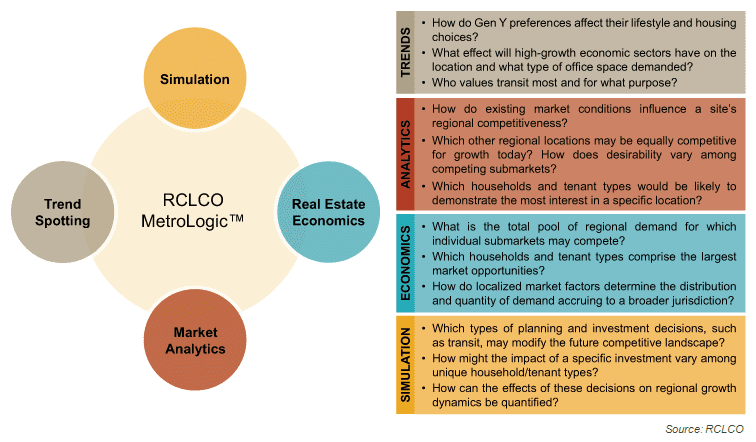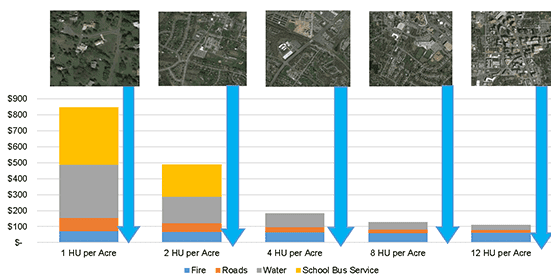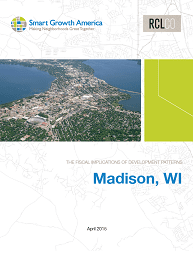RCLCO Launches a New Methodology: MetroLogic™

How can a property or jurisdiction enhance its competitiveness for growth? What impact will evolving consumer preferences have on development patterns over the long term? How can a public investment, such as transit, modify the future competitive landscape? What are the most promising development opportunities for a particular site or community? How does a potential real estate investment opportunity stack up against other options?
RCLCO has created the customizable MetroLogic™ modeling platform that presents a valuable addition to the toolbox of methods RCLCO uses to forecast future development patterns, and to assess development and investment opportunities, under varying assumptions. The dynamic nature of this model enables RCLCO to evaluate quantitatively the effects of alternative scenarios and infrastructure investments on specific locations, jurisdictions, and regional growth patterns.
MetroLogic™ integrates core RCLCO knowledge bases to evaluate and forecast competitiveness for development and investment:

Trend Spotting
RCLCO’s proprietary research and forecasting delve deeply into the likely impacts of changing consumer preferences, local and global economic forces, and supply-induced demand. RCLCO has pioneered methods of quantifying demand for higher-density, walkable environments; demand for transit-oriented development; and the potential future impact of Gen Y and downsizing Boomers on housing and office markets nationwide. Meanwhile, our research into the market for and future of sustainable development—including transit-oriented development and “green” buildings—provides us with optics on future demand that enable us to identify market opportunities that conventional analysis can miss. RCLCO has for many years conducted pioneering research into metropolitan growth patterns, including the concepts of “favored quarter” and Metro Core generation, which are also taken into account in our forecasts.
Market Analysis
Using a data-driven approach to evaluate key microeconomic factors and local real estate market conditions, MetroLogic™ models how locations are likely to compete for shares of regional growth. Many of these factors focus on user experience—measuring accessibility via roads and transit rather than general proximity. This methodology then incorporates RCLCO’s cutting-edge consumer research and trend spotting to weight the relative importance of these factors among different office tenant categories and household demographic segments. By integrating consumer preferences and local market analytics, MetroLogic™ produces a score indicative of each location’s relative competitiveness to attract specific types of growth under existing and likely future conditions.
Real Estate Economics
MetroLogic™ deploys RCLCO’s best-in-class methodologies to directly estimate demand for office, retail, hotel, and residential development. Beginning with current economic and market conditions, economically and demographically derived statistical demand models take into account current and future conditions of supply and demand—and trends in occupancy, vacancy, and lease/rent rates—and then incorporate the local site competitiveness scores. This modeling yields detailed insights into market opportunities in the near, mid, and long terms—up to 20 years or more—at both local and regional levels.
Simulation Modeling
RCLCO’s Dynamic Real Estate Scenario Impact Modeling enables RCLCO to model the outcomes of a variety of market interventions, major new developments, and other changes that may affect real estate investment and development opportunities. As an integral component of the MetroLogic™ geospatial modeling platform, this tool directly modifies the local microeconomic and competitiveness factors that would be affected by a specific planning or investment scenario. It helps answer questions such as:
- If a new transit line or highway is built, how will regional growth dynamics respond, and how will development opportunities for a particular site change?
- If a proposed transit alignment changes, how will real estate markets react?
- If a new retail project can be created on a site or along a corridor, what will be the effects on its community or the region as a whole?
- What is the potential to create a new employment core, and what effects would it have on other development opportunities?
Disclaimer: Reasonable efforts have been made to ensure that the data contained in this Advisory reflect accurate and timely information, and the data is believed to be reliable and comprehensive. The Advisory is based on estimates, assumptions, and other information developed by RCLCO from its independent research effort and general knowledge of the industry. This Advisory contains opinions that represent our view of reasonable expectations at this particular time, but our opinions are not offered as predictions or assurances that particular events will occur.
Related Articles
Speak to One of Our Real Estate Advisors Today
We take a strategic, data-driven approach to solving your real estate problems.
Contact Us







